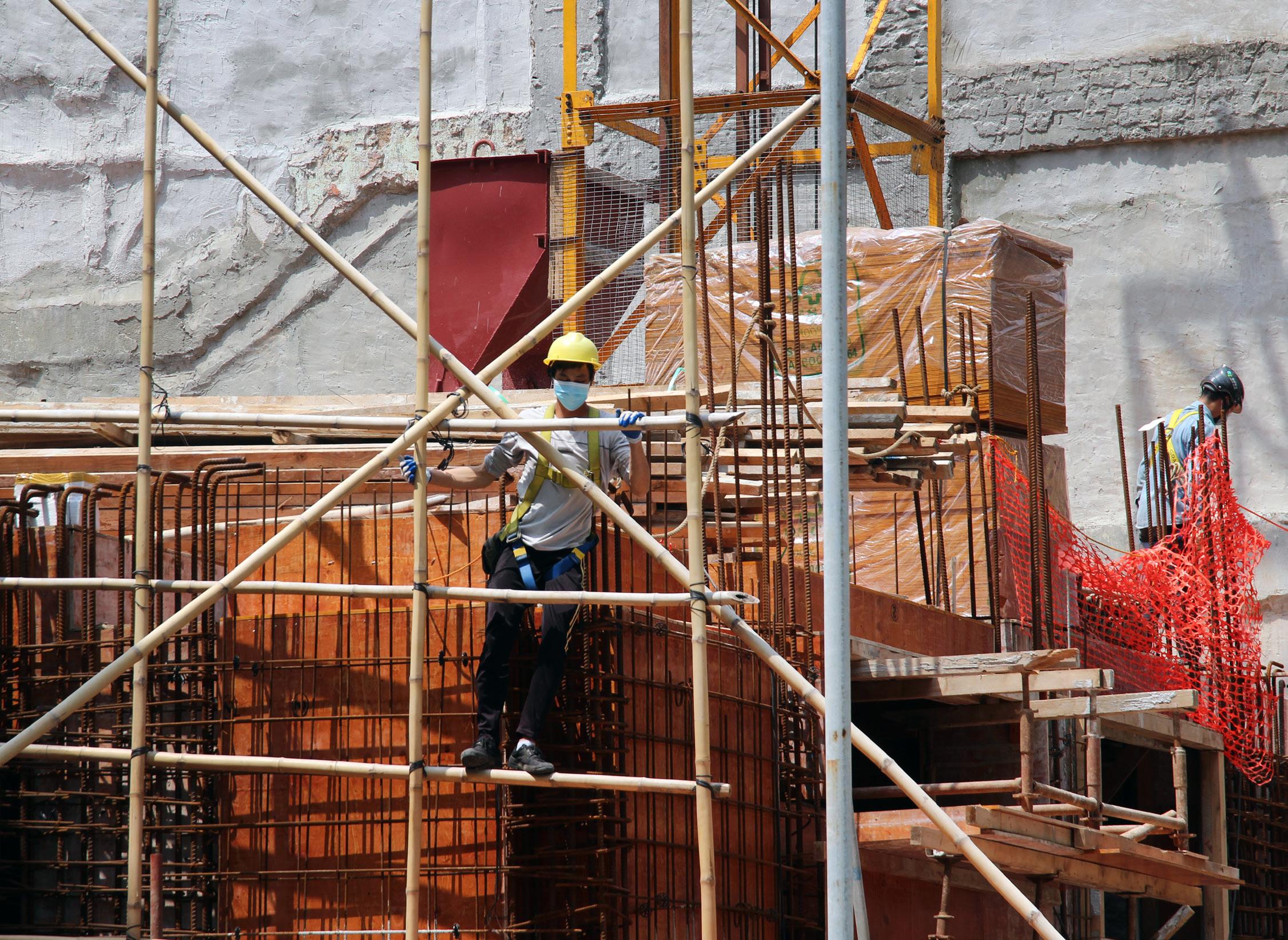
11 minute read
Covid-19: Asia-Pacific leads Global Recovery from Pandemic
By Rajiv Biswas, APAC Chief Economist, IHS Markit
Summary
Advertisement
The Asia-Pacific (APAC) region has been badly hit by the impact of the Covid-19 pandemic during H1 2020, with lockdown measures and travel bans in many Asian economies having triggered sharp contractions in GDP growth. The pandemic and associated lockdowns have disrupted industrial production and consumer spending in many Asian economies, with the tourism industry in the Asia-Pacific having collapsed since March 2020.
However, with the number of new Covid-19 cases slowing to very low levels in many APAC economies during May, domestic lockdown measures are being eased in a growing number of nations. Recent Purchasing Manager Index indicators for June 2020 have already rebounded significantly in mainland China. The latest PMI indexes across the Asia-Pacific region also signaling a significant rebound in domestic demand in some other APAC economies, including Japan, Australia, Malaysia and Thailand. Improving APAC economic growth momentum is expected in H2 2020, as domestic demand gradually recovers from lockdowns while export orders from key markets in Europe and North America also improve. By 2021, with the pandemic expected to be contained, a stronger economic rebound in expected in the APAC region, led by buoyant growth in China.
China leads APAC economic recovery
As the Covid-19 pandemic escalated in China during the first quarter of 2020, it created severe disruptions of industrial production due to the strict lockdown imposed on industries and households. The normal annual shutdown of China’s industrial production during the Chinese New Year holiday period which occurred in late January was followed by a national lockdown that extended until mid-February.
As a result of the lockdown, China’s industrial production sales narrowing to 2.8% y/y.
halted for a protracted period of time, disrupting production and shipments of industrial materials, intermediate goods and finished products from the world’s largest manufacturing hub for many weeks. Restrictions on the movement of workers within China also created further delays to the process of restarting factories once the lockdown was gradually lifted.
However as Chinese factories ramped up output during April and May, industrial production recovered rapidly. By May, industrial production was up 4.4 % year-on-year, while production of high technology goods rose by 8.9% year-on-year. However new export orders have contracted sharply during Q2 2020 due to the impact of lockdowns in key markets, notably the US and EU. With lockdowns in the US and EU being lifted during May and June, new export orders are expected to gradually improve While the recovery in China’s domestic consumer demand has been relatively gradual, with retail sales in March down 15.8% year-on-year, this had improved significantly by May, with the decline in retail
during H2 2020.
China’s vehicle sales rebounded during May, helped by a strong surge in sales of commercial vehicles, which rose by 48% y/y, while passenger vehicle sales rose by 7% y/y. This compared with a 42% y/y decline in vehicle sales during Q1 2020.
With China also having completed successful Stage 1 and 2 clinical trials for three different Covid-19 vaccines, this could also help sustained recovery in domestic demand during H2 2020 and during 2021, if vaccines completed Stage 3 trials and are able to be rolled out to a large proportion of China’s population by late 2020 and early 2021. Consequently, China’s GDP growth is expected to rebound in 2021, growing by 7.8% y/y.
Caixin China General Manufacturing PMI
sa, > = improvement since previous month
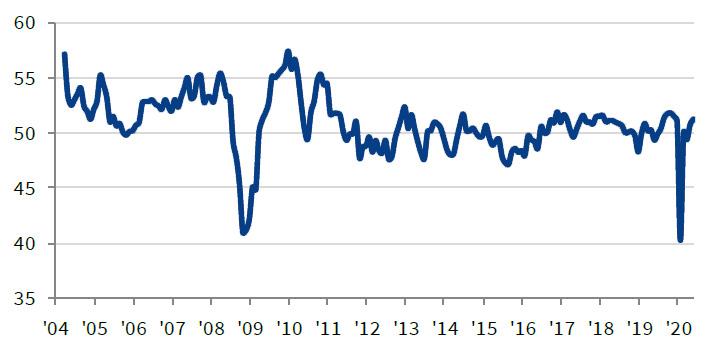
Source: Caixin, IHS Markit
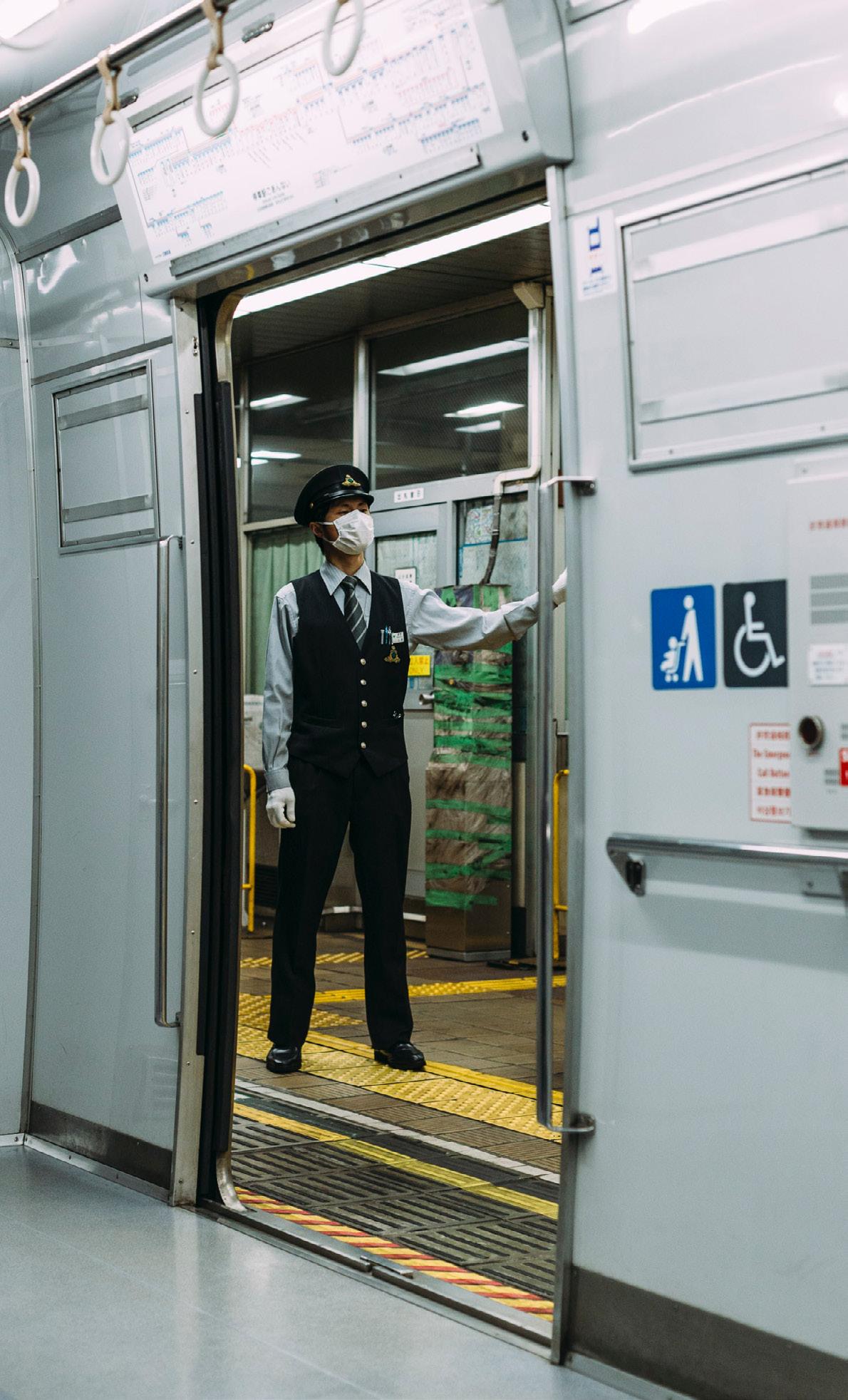
Japan’s Services Business Activity Rebounds
Japanese Prime Minister Shinzo Abe announced State of Emergency measures on 7th April to combat the escalating number of Covid-19 cases in Japan. These measures were initially applied to certain prefectures, which were later extended to the whole of Japan on 16th April. Due to Japan’s success in containing new cases during May, the State of Emergency ended on 25th May. Due to the protracted period of weak consumer spending during the duration of the State of Emergency, both domestic manufacturing new orders and services sector activity were badly impacted.
Due to the State of Emergency measures, the au Jibun Japan Services Business Activity Purchasing Manager’s Index slumped to a record low of 21.5 in April, but improved to 26.5 in May.
The lifting of the State of Emergency in May was a key positive factor for domestic consumption expenditure, boosting services activity levels. This resulted in the Flash Japan Services Business Activity PMI rebounding strongly to 42.3 in June, albeit the index still remained below the 50.0 neutral level, signaling some continued contraction in the services sector.
Meanwhile, the global slump in economic activity during Q2 2020 has also hit Japanese new export orders. Provisional
au Jibun Bank Japan Composite Output PMI
PMI, sa, > 50 = imrpovement since previous month
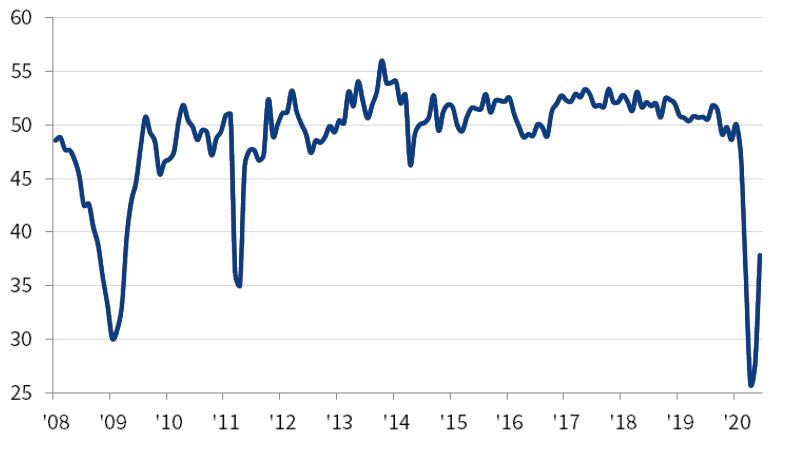
export data from the Japanese Ministry of Finance show that exports in May contracted by 28% y/y. This followed a 22% y/y contraction in exports for the month of April.
Reflecting slumping exports, the Japanese manufacturing sector remained weak, with the au Jibun Bank Japan Manufacturing PMI at 41 in June, still below the neutral level of 50 and indicating continued contraction in the manufacturing sector. The manufacturing sector has been hit by weak global export orders, which has constrained any rebound in manufacturing conditions. Japan’s industrial production fell by 25.9% y/y in May and was down 8.4% month-on-month. Japanese government survey data from companies points to a significant rebound of 5.7% m/m in June and 9.2% m/m in July.
Japan’s GDP contracted by an annualized 2.2 percent in Q1 2020, the second consecutive quarter of GDP decline, pushing the Japanese economy back into another recession. Due to the State of Emergency conditions, Japanese GDP is expected to contract again in Q2 2020, before gradually recovering in H2 2020. In calendar 2020, Japanese GDP is expected to return to positive annual economic growth of around 1.8% y/y.
South Korean Domestic Demand Improves but Exports Slump
South Korea’s success in containing the escalation in new Covid-19 cases during March has allowed South Korean domestic demand to improve during April and May, with the number of new cases still remaining low during June. According to data from the Ministry of Trade, Industry and Energy based on surveys of major retailers, South Korea’s retail sales in May rose 2.0 percent compared to the same period last year, with online retail sales having jumped 13.5 percent y/y.
However South Korea’s export sector has been hit hard by the impact of lockdowns in key markets such as the US and EU. Ministry of Trade, Industry and Energy data show that South Korea’s exports in May saw a year-on-year decrease of 23.7 percent to USD 34.9 billion. Auto exports dropped 54% percent to USD 1.8 billion, due to the falling global demand in major markets, notably the United States and Europe. In May, South Korean merchandise exports to the US fell by 29%, while exports to the EU were down 25% percent and shipments to ASEAN fell 30%, impacted heavily by lockdown measures in these markets.
Join over 3600 other industry experts in the ICISA group on LinkedIn.
Australian economy rebounds in June as lockdown eased
Although Australia has managed to rapidly contain its COVID-19 epidemic, the impact of lockdown measures and travel bans is expected to push the economy into its first recession in 29 years.
GDP growth in Q1 2020 already recorded a contraction of 0.3% quarter-on-quarter, with lockdown measures only having impacted on the economy in late March. However, with severe lockdown measures and travel bans in place during much of Q2 2020, the economic contraction in the second quarter will be much more severe. Nevertheless, with COVID-19 restrictions starting to be gradually eased in May and June, a gradual improvement in economic growth momentum is expected in H2 2020.
Commonwealth Bank Flash Composite Output Index
sa, > 50 = growth since previous month
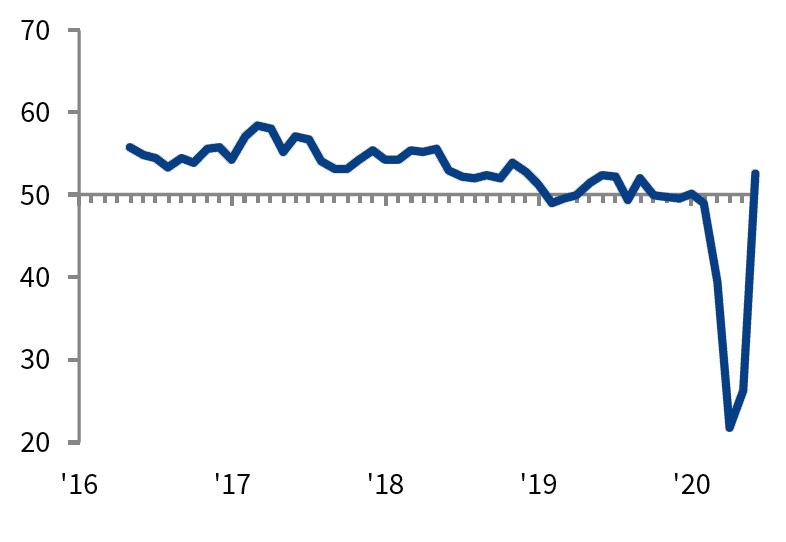
The latest Commonwealth Bank of Australia Flash Composite Purchasing Managers Index for Australia showed a very strong rebound from a level of 28.1 in May, signaling severe contraction in the economy, to 52.6 in June, indicating renewed moderate expansion. However with international travel bans still impacting severely on some sectors of the economy, notably tourism, international education and commercial aviation, the pace of economic growth in 2021 is expected to be moderate, at around 1.9%.
Southeast Asian Economies Hit by Lockdowns
The economic impact of the Covid-19 pandemic across the ASEAN region has been mixed, with some nations such as Vietnam having largely avoided any significant domestic epidemic, while other nations such as Indonesia, Philippines and Singapore have suffered more severe economic shocks. Indonesia, which is the largest economy in ASEAN, is still facing a high level of daily new Covid-19 cases, increasing the uncertainty about how long and protracted the impact of the domestic epidemic will be on the national economy. In Singapore, the protracted lockdown is expected to result in a severe contraction in Q2 GDP, plunging the economy into a severe recession for 2020.
Vietnam has been very resilient to the economic shocks of the pandemic, with the total number of domestic Covid-19 cases very low during H1 2020, at just 355 persons, with zero deaths. Consequently domestic demand has been remained firm, with retail sales down just 0.8% y/y in H1 2020. Industrial production has also been robust, with manufacturing output up 4.6% y/y in H1 2020, helped by a 9.8% y/y increase in output of computer, electronic and optical products.
Malaysia and Thailand experienced a rising number of new Covid-19 cases during March and early April, but were able to control the number of new cases significantly during May, allowing the easing of lockdown measures. Despite the easing of lockdown measures, both nations are expected to experience recessions in 2020, reflecting the slump in consumption spending in recent months as well as the decline in exports to key global markets. The collapse in international tourism is also a significant negative factor for both economies.
The latest IHS Markit PMI surveys for Malaysia and Thailand show a rebound in economic activity as domestic lockdown restrictions have been gradually eased during Q2 2020.

India Faces Recession due to Protracted Lockdown
India Manufacturing PMI
In India, a national lockdown began on 25th March and has continued in various phases during June, albeit with significant easing of restrictions since early May. This protracted lockdown has resulted in the severe disruption of industrial production and consumer spending, with GDP growth forecast to contract sharply during Q2 2020, pushing Indian GDP growth for the 2020-21 financial year into a deep recession. However, unlike many other countries which have eased lockdown measures, India has faced continued escalation in the number of daily new Covid-19 cases during June. Consequently the future path of lockdown measures remains highly uncertain, particularly if new daily cases continue to escalate.
As a result of the lockdown measures, Indian industrial production was heavily disrupted during late March and during April, although a limited restart of certain industries has gradually occurred since 22nd April. Indian industrial production fell by 55.5% y/y in April. Manufacturing output, which accounts for 77.6% of the total industrial production index, declined by 64.2% y/y in April.
The services sector has also been badly hit by the impact of lockdown measures on retail trade and the collapse of domestic travel and tourism.
The severe recessionary conditions in 2020 are also expected to further drive up non-performing loans in the Indian banking sector, adding further downside risks to the path of economic
recovery in 2021.
sa, > 50 = imrpovement since previous month
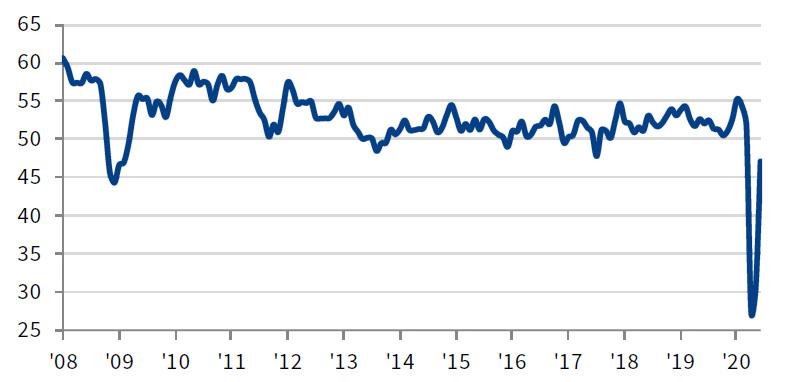
Outlook
Due to the impact of the pandemic-related lockdown measures and international travel bans, the Asia-Pacific region is expected to be in recession in 2020.
However, the significant moderation in the number of new Covid-19 cases in many major economies in the APAC region in recent months has created the platform for a gradual recovery of domestic demand during H2 2020.
A gradual recovery in other major economies during H2 2020, notably the US and EU, will also help to drive a rebound in new export orders for the Asia-Pacific export sector.
China, the world’s second largest economy, is leading the world recovery, with economic activity rapidly returning to more normal levels for both manufacturing and services. A key strength supporting China’s rapid economic rebound is the large size of the domestic consumer market, which has helped to support improving new orders in both the manufacturing and services sectors. Strong growth in China in 2021 is expected to boost the export sectors of many other Asian economies, given the importance of China as a key market.
Overall, GDP growth momentum is expected to gradually improve in the APAC region during H2 2020, helped by improving domestic demand and an upturn in new export orders from key global markets, notably the US and EU. In 2021, renewed positive growth is forecast for the APAC region as the pandemic fades, with regional growth momentum buoyed by a strong economic rebound in China.
